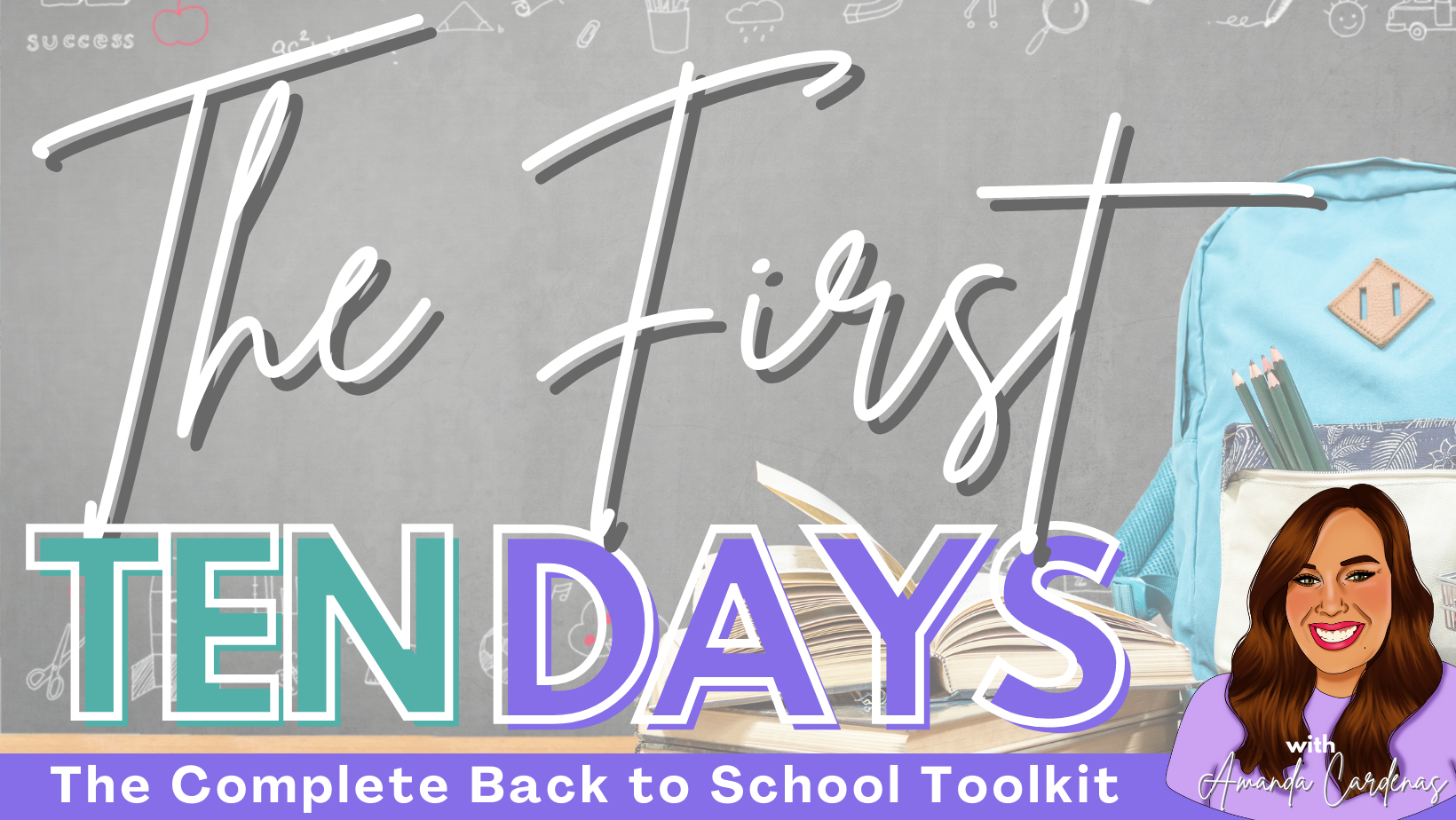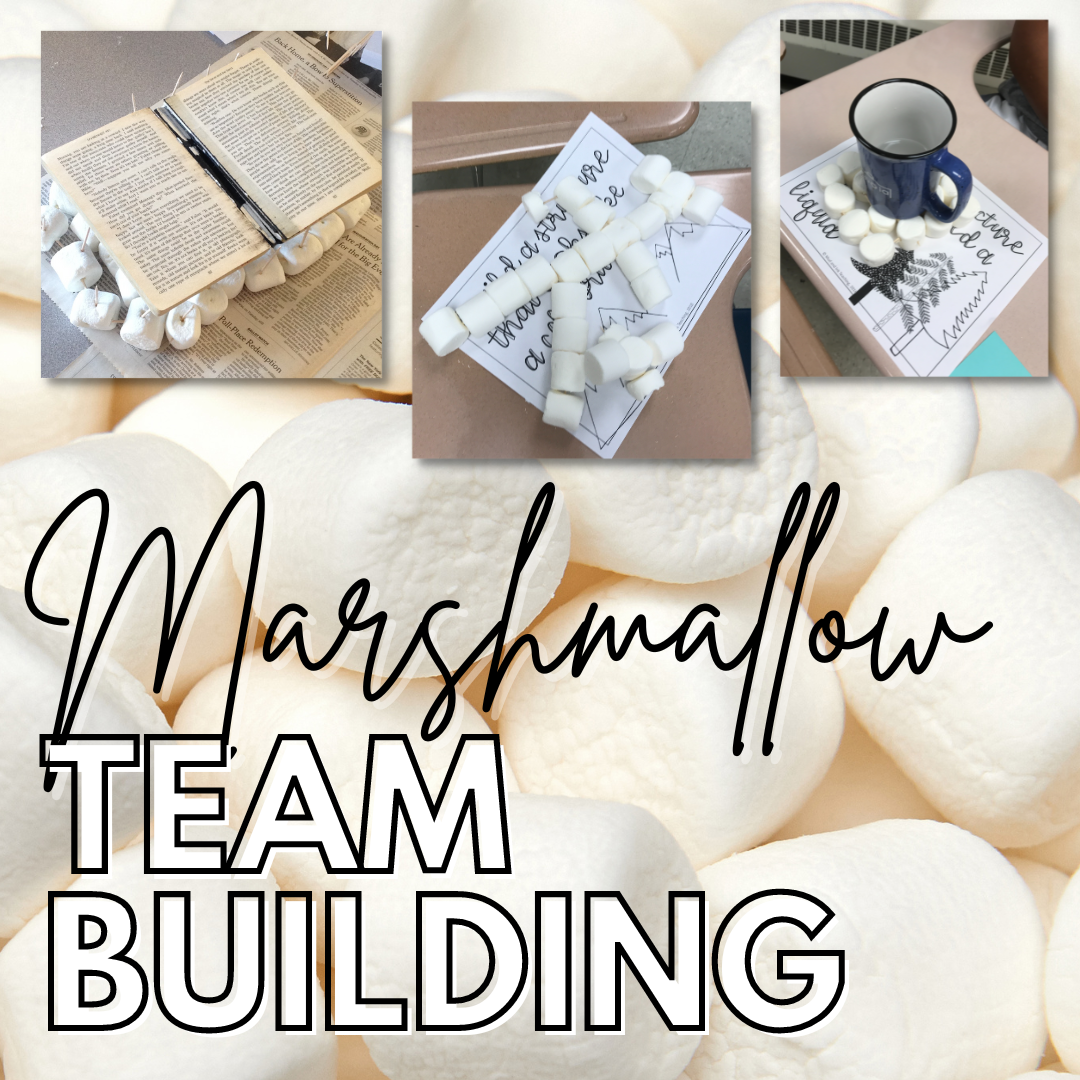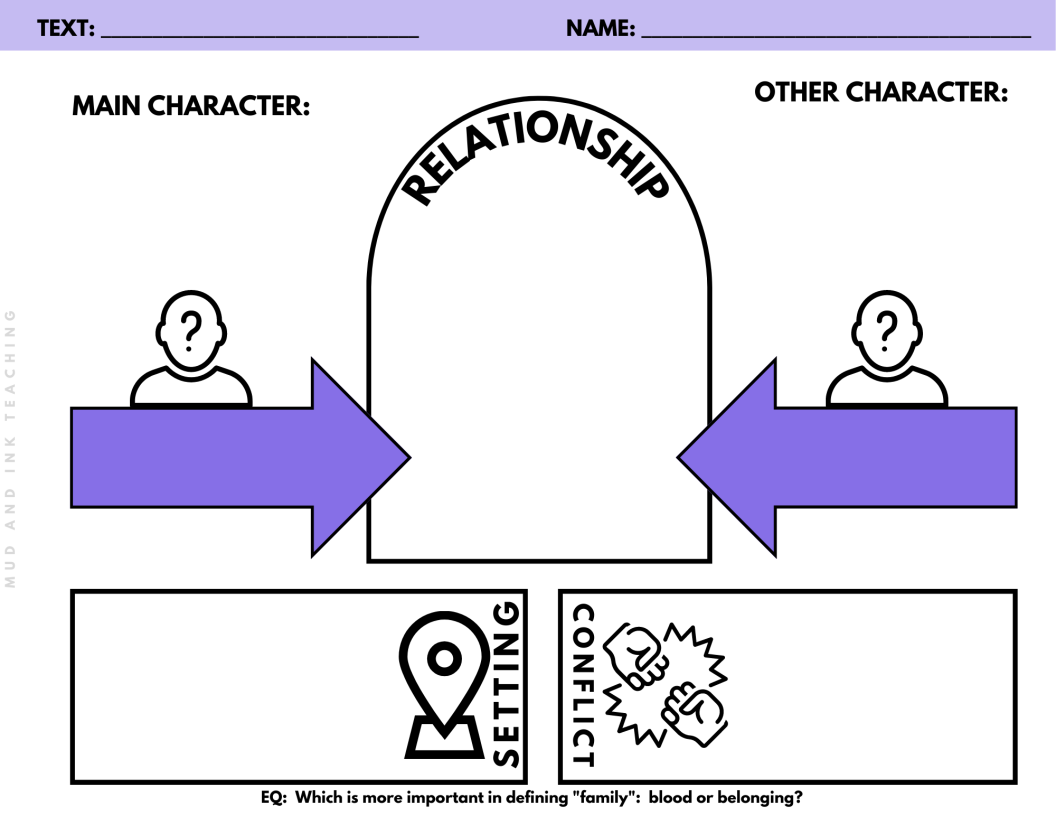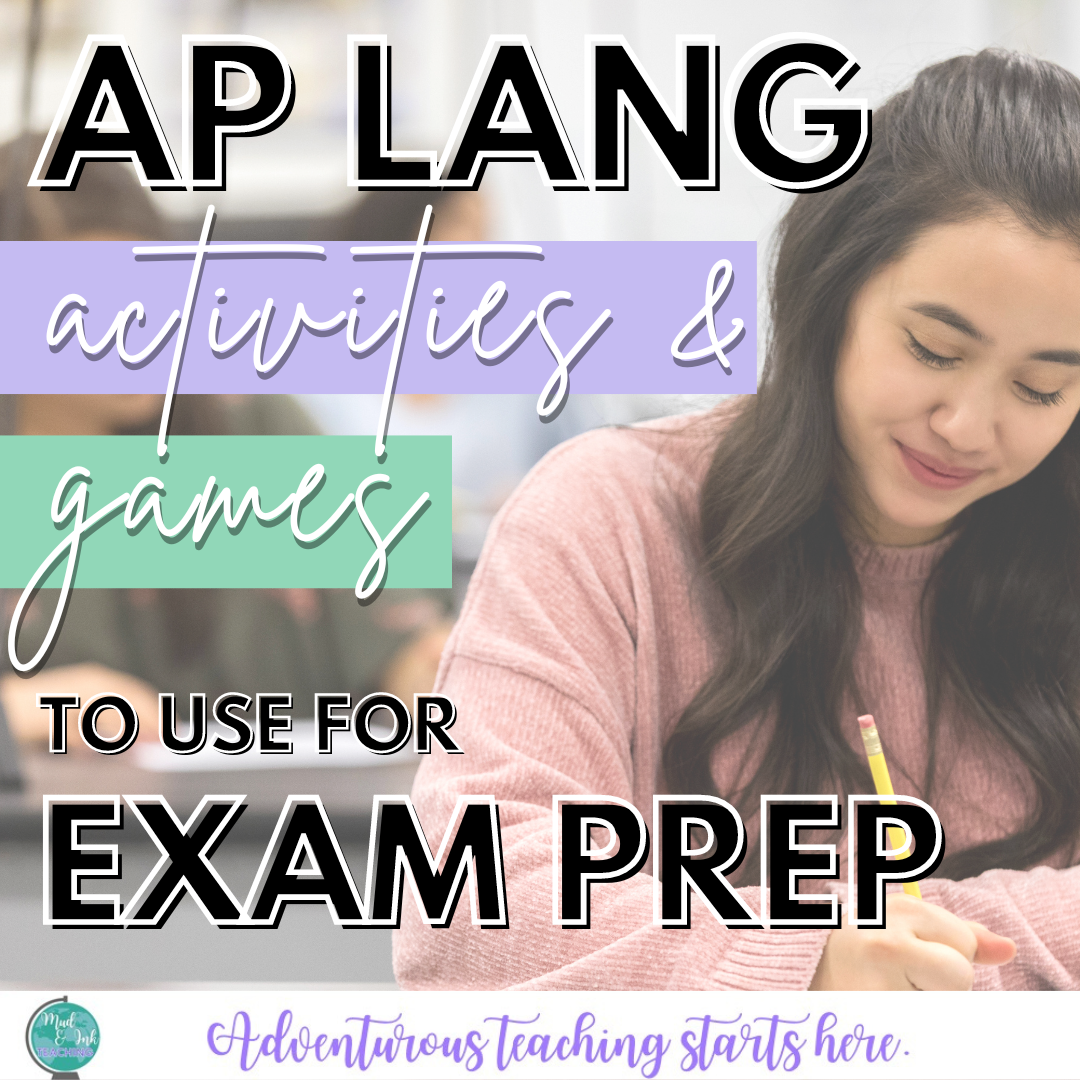The First Ten Days of School - Routines, Rigor, and Relationships
The First Ten Days of School - Routines, Rigor, and Relationships
It’s every teacher’s most stressful, most highly anticipated, and most powerful time of the year: back to school! After over a decade of first days back to school, I’ve finally found a plan for the first ten days that streamlines the three most important things for me: routines, rigor, and relationships. Here, I will outline for you the importance of routines, rigor, and relationships, then, provide my daily plans for the first ten days.
It’s not the most pinterest-worthy or “cute” part of the job, but routines from these first two weeks are, I would argue, the top priority. Yes, even above building relationships. I can say this because I’ve been there before: it’s really hard to build relationships in a class where the classroom management is out of control. By establishing key routines, you’ll be setting the tone for a classroom that is respectful, runs smoothly, and can operate on its own while you take time to meet and confer with students on a need-to basis.
Here are the routines that are essential to establish in my first ten days:
Start and End
The daily starting and ending routines of my classroom are the most important. To start my class, I’ve always aimed to have a routine that students can do independently, silently, quickly, and meaningfully. And, an added bonus if it doesn’t need to be graded immediately! Enter: BELL WORK! Every year I tweak exactly what we do, but I always end up using a version of one of these two systems: my vocabulary bell work notebook and my digital bell work notebook. Students have access to the digital notebook on their chromebooks and I control the exercise that they will complete each day. Sometimes students are creating a meme based on the reading from the night before, sometimes they’re writing a personal reflection, and other times they’re looking up the perfect song on YouTube to capture the mood of a poem. No matter what, they’re able to read my screen at the front, take out their chromebooks, start and complete the assignment independently, silently, quickly, and meaningfully. I need this time to do so many other important micro-tasks. I’ve used this first 5-7 minutes to return work to students, have a one-on-one conversation with a student in the hall, take a few deep breaths, send a quick email to a parent about an issue from the previous class period…you name it! I NEED these minutes, but I am not willing to waste them, either. So, bell work has been my solution. Since it’s assigned digitally, I collect it via Google Classroom at the end of a unit (or end of a week depending on the class/level/task), so I’m able to look at their over their work all at one time and it’s not another daily to-do.
To end class, I have three clear directives: “It’s time to pack up!” I take time practicing this with students - they are not packing up their things until they hear this phrase. It is a HUGE pet peeve of mine, and on the whole, I’ve learned that pet peeves can be solved by creating and practicing routines, so this is one of them! After they hear me say that, they remain “cheeks in chairs”. Yup. That’s high school talk for sit in your chair and DON’T LINE UP AT THE DOOR. Finally, when they hear “Have a great day!” (which I usually say with the bell), they are dismissed.
This probably sounds like a lot. And it is. You’re only four paragraphs in to this post so far. But trust me: figuring out your version of what works for your starting and ending routines are what save you down the road. They improve the quality of your lessons, they foster respect, and, not to mention, they’re things that visitors to your classroom notice (AKA observations!). Check out my TpT store for lesson ideas for your next observation or to kick off a new semester!
Movement
We use stations ALL the time and having students know how we do stations is essential for my classroom management. We practice stations during these two weeks and I train my students to move with this doorbell from Amazon. When they hear the bell, they know it’s time to move. When they’re at a station, they are to stay on task until the bell has rung, then, they have a break. They can move, hi-five someone from across the room, but then at the second bell, they should be at their next station prepared to work.
You’ll also want to consider the ways in which you want to permit students to move in and out of your classroom (hallways, bathroom, etc.). I use a QR code attached to a Google form to track tardies as well as students going in and out of the bathroom.
Work Submission
Do you have all of your work collected on Google classroom? A turn in folder? A combination of both? Whichever it is, make sure that during these first two weeks you assign multiple items so that students can practice your turn-in routine (and you can practice how you hand things back!). Don’t assign work just to assign it - it should be meaningful - but make sure the assignments are handed in and scored in a way that reinforces your routine expectations! I always assign a letter of introduction for my students to write and I use this opportunity to teach my turn in policies: if it’s assigned on Google Classroom, it must be turned in on Google Classroom. On the day the letter is due, I go right into Classroom and put the assignment in the gradebook: checks for turned in and ZEROS for anything not turned in. This sets of a red flag really quickly, but more importantly, a teachable moment. It takes students a few assignments to get over the “but I didn’t click turn-in” or “I thought I had to print it, but there were no working printers, and my grandma was visiting from out of town, and my turtle escaped from his tank, so I couldn’t get it to hand in to you” excuses. Every single time an assignment comes in, we go through the same routine. If you’re pulling out your hair in December about something that drives you crazy, create a routine that solves it, then implement that routine in the first two weeks. Dedicate time and energy to this routine as much as you can and you’ll find that the rest of the year is so much more tolerable!
Technology
I have students using their Chromebooks every day in my classroom, so establishing a daily routine of taking out your CHARGED Chromebooks needs to happen! I purposefully plan Chromebook related activities to make sure that students are in the habit of bringing it every day to my room ready to go. Even if the assignment is as small as an exit slip, purposefully scheduling time for students to need their Chromebooks is essential.
Ready for the next level?
If you’re loving this blog post, but could use more support, you need to check out my COMPLETE Back to School Toolkit - The First 10 Days! This course will hold your hand through over a dozen asynchronous video trainings led by me. I’ll share with you the why, the how, and the when for planning and implementing the best back to school season ever!
During the first two weeks, students get several assignments from me, each with a specific purpose. Some of them help me teach routines (see above!), others help me demonstrate my grading policies and what I have outlined in the syllabus, but the others are designed to help me craft an atmosphere of high expectations and rigor in my classroom. In the first ten days, I assign both “classwork” (assignments that are checked-in pass/fail) and “assessments” (assignments that are graded on a rubric). I train students to read their gradebooks accordingly. In these first ten days, I will assign the following:
Classwork:
Student/Parent Syllabus signature
Cell phone policy contract
Email etiquette assignment
Assessments:
Bell work (graded at the end of the unit)
Letter to My Teacher
Socratic Seminar
I think sometimes high expectations and rigor can be misinterpreted as “teacher-centered” or being inflexible. For example, with one of my first assignments, the letter mentioned above in the ROUTINES section, I set a hard line on work that is turned in late. Zeros go in the grade book if the assignment is not turned in on Google Classroom. Period. When students come with excuses, I simply respond, “That’s fine! I just have this zero here as a placeholder and reminder to you and everyone who can see this 24/7 internet-based gradebook that I have not received it from you. When I do, that zero will change, but until then, it’s just gonna stay that way.” This might sound harsh - how could I do this when I don’t even know my kids yet? How could I do this when I don't know what hurdles they could be facing outside of school?
We can’t build strong relationships around lax routines and procedures - we have to start strong with firm expectations. Remember, being firm and clear in building a strong academic culture in your classroom doesn't mean that you’re ignoring student needs. Expecting responsibility, strong worth ethic, and a commitment to high standards DOES MEAN that you care about your kids, deeply.
And, while we’re on the subject, this is a good time to think about your curriculuar approach for the year — have you made the shift to inquiry-driven instruction? A makeover of your short story unit might be a great place to start…
With an efficient, respectful set of routines established and an atmosphere with high academic expectations cultivated, powerful relationships grow. At the start of my career, I thought relationships were the only thing that mattered. I wanted to reach every kid and know everything about their lives, their families, their backgrounds, their struggles. And I did. I went to games, I called home, I did surveys, I wrote personal letters, I sponsored the clubs that no one else would sponsor, and I did it: I built GREAT relationships! But, there were some consequences to this approach that I didn’t see coming.
First was the burnout. I was weighed down with so much emotional baggage and physical stress (the only way to do all of these things for my students was to completely ignore my own health, of course) that I burned out fast. I’m a happy person that burned on adrenaline to survive, but as close as I was with my students, it was the worst I’ve ever felt physically in my life.
The second is the more embarrassing one to admit. Most days in my classroom were a total flop. Since I prioritized relationships above all else, I never really considered how I was going to control the workflow of my classroom and be everyone’s “cool” teacher all at once. Since I knew everyone’s issues, I was willing to forgive bad attitudes, accept work (extremely) late, and let students take fifteen minute bathroom breaks. I thought I was meeting their needs and caring for them. But in reality, the learning environment was not one of respect: it was one where my kindness and flexibility were taken advantage of. I was too close to push my students to meet their academic potential and too much time was wasted. It took me years to find that routines and rigor were truly the foundation to building the kind of relationships that I really wanted in my classroom.
Here is the kind of relationship I’m committed to having with my students: one where they know I care so much about them that I want not only to support them in times of need, but also where I can push them to grow in ways they may have never gone on their own. One where I can say, “Listen, I know what’s going on at home is really tough on you right now, but here’s what else I know. I know you can do this. I know you can handle this assignment and feel really proud about what YOU did, and not sad about the other things going on that are out of your control. If you need an extension, we’ll make that happen, but I really believe in you and I believe you can do a great job.” Take time to think about how you want to define your relationships with students. Then, build the kind of classroom that will help those kinds of relationships grow.
Day 1: Marshmallow Team Building (RELATIONSHIPS)
Our first day is typically a shortened class period, so I always have this lesson ready to go. Marshmallow team building is a quick way to get students working together, being creative, and establish a classroom culture of student-centered learning. I have a handful of other possible options listed here!
HW: None
Day 2: Debrief, Expectations, Syllabus (RIGOR & ROUTINE)
The next day, we debrief the marshmallow team building exercise. What was the experience like? How did your team work together? What were the struggles? I let this conversation flow into an overview (not word-for-word reading!) of our class syllabus. I’ve done more interactive versions of this, but I’ve found that I want to be very clear and direct the first time through our expectations, so I give it to them pretty straight. We reinforce and practice these different parts of the syllabus later, but this day is typically pretty dry - on purpose! One thing that helps has been moving my syllabus to a digital format. Instead of reading a paper syllabus, my students receive their Google Classroom codes and open their syllabus that I’ve created using Google Sites. This allows us to look through the “boring” stuff, but also watch book trailers for the novels we’ll be reading and experience the other interactive elements on the site.
To close class, today we practice our closing routine: “Time to pack up”, “Cheeks in chairs”, and “Have a great day!”
HW: Parent & student syllabus signature (on a Google form attached to the syllabus)
Day 3: Meet the Teacher / letter to your Teacher (ROUTINE, RIGOR & RELATIONSHIPS)
I continue establishing relationships on Day 3 by sharing a few pictures and stories about my life. I tell students that it’s important to me that they know who I am, who I love, what I care about, what makes me laugh, and what my life is like outside the classroom. It’s important to me that they’re not coming to a classroom to learn from a stranger. I share with them, very transparently, my journey to becoming a teacher and how much I love coming to work every day, but also how I love going home to my family and traveling the world. I want them to see me as a whole person, and then, I ask them to do the same. Students then write me a letter of introduction (routine - turn in on GClassroom; rigor - graded on a rubric as an assessment; relationships - getting to know their stories).
Today is the second day of practicing our closing routine.
Day 4: Intro bell work routine / Pocket Points tutorial / First Text (ROUTINE & RIGOR)
On Day 4, we begin our most important routine (and one that takes quite a bit of practice!): bell work! This takes about three times as long as normal, so we go slow and practice. With the remainder of the class period, we discuss and practice our cell phone policy and practice it with a text (short story, quick article, etc.) . This year, we will be experimenting with Pocket Points, so the plan is for students to get logged in and do their first reading session in a small group. The text we will use during this session will be connected to their upcoming socratic seminar and I’ll have them reading with a small group.
This is the third day we practice our closing routine.
HW: Continue Letter to My Teacher
Day 5: Bell work / classroom stations (ROUTINE & RELATIONSHIPS)
Class starts again with bell work training. We slowly start trying to increase independence and reduce time spent on the task. The plan for the rest of the day is to do one of my favorite activities: classroom stations! Each year this varies, but basically the goal is for students to get a tour of my classroom while using the classroom routine procedure of stations. My six stations include:
Technology Station: register for Actively Learn accounts
As students move through the stations, we practice movement (as stated above!) using the doorbell from Amazon.
Of course, we close class by practicing our closing routine again!
HW: Finish Letter to My Teacher
Day 6: Intro Socratic Seminar (ROUTINE & RIGOR)
Bell work continues.
Collect Letter to My Teacher.
Socratic Seminar is one of my absolute favorite types of assessment. I first heard about seminars a while ago, so I observed many in action and did some research. My go-to for seminars, however, is from the incredibly talented Esther Wu on Teaching Channel. I love how she does seminar and I’ve been doing an adapted version for years!
On this day, I teach students what seminar is, show them a seminar in action, go over our rubrics and expectations, and assign them a short list of texts that we will be discussing. Each year, this list changes. Last year, our seminar was designed around summer reading. This year, it will be tied to our first unit’s essential question. Either way, I design the questions (and students write questions to add) that are both text-dependent AND opinion/experience-based. I want students to do a lot of things in a seminar, but for the first one, I really just want everyone to TALK.
Here’s the video I show students and the resources that I learned from.
Closing routine continues.
HW: Read through one text on the list & annotate
Day 7: Seminar Prep Day (routine & rigor)
Bell work continues.
The next day we will spend preparing for seminar. Depending on the age and level of the students, this day might be spend heavily on reading additional texts to help our conversation, it might be spent taking a more in depth look at the video from the previous day, it might be an interactive presentation of the rubric so students know how they’ll be assessed, or some combination of all of these things. Either way, students usually need a day to get read for seminar rather than just jumping right in. I usually also take this day to practice more routines (if needed) or do a small partner exercise (for relationship building).
Closing routine continues.
HW: Complete reading texts for seminar; complete seminar prep sheet
Day 8: Day 1 Seminar (routine & rigor)
Bell work continues.
Collect seminar prep sheet from Day 1 students.
If you had a chance to look through the Teaching Channel video linked on Day 6, you’ll know that these seminars are broken into two days. The group for Day 1 will seminar today. While students are in seminar, I am taking notes and giving feedback.
Closing routine continues.
HW: Complete role sheets & coaching sheets
Day 9: Day 2 Seminar (routine & rigor)
Bell work continues.
Collect seminar prep sheet from Day 2 students.
This day looks identical to the previous day, but the students in the center circle have shifted. I continue taking notes and giving feedback on the discussion.
Closing routine continues.
HW: Complete role sheets & coaching sheets
Day 10: Socratic seminar reflection & goal setting (routine & relationships)
Bell work continues.
Collect any remaining role sheets and coaching sheets.
On the day after our first socratic seminar, we take time to reflect and celebrate. Typically, I’ll have students do a silent chalk talk and share their experiences on the board. Anything you like to do for reflection would be great here, but make sure you find time to also set group goals for the next seminar! How did we do overall with incorporating evidence? Did seminar sound like everyone reading their homework out loud or an organic, meaningful discussion? What can we do to improve for the next seminar? These are important questions to address together, so be sure to find time to do this!
Closing routine continues.
I hope this article has helped you start to envision the first ten days of your own school year. I’d love to hear your version of these critical days - how do you set these days up? Have any of these ideas worked for you? Be sure to share in the comments - I can’t wait to connect with you!






































